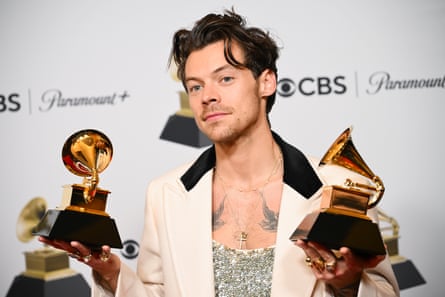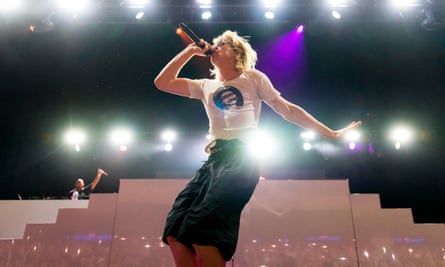Last month, US rapper Azealia Banks published an Instagram story in which she labelled the Australian music industry “ever dwindling”, “insignificant” and “culturally stale”.
In her posts – which also contained allegations about dealings she had with an Australian music company – Banks shared a screenshot of a Guardian story about how streaming platforms were affecting the country’s listening habits; it noted that just 22 of the 296 songs included in Australia’s weekly Top 50 across 2022 came from Australian musicians. “Australians don’t even want to hear Australian music LOL,” Banks wrote, adding that that was a “correlation between the government’s purposeful ethnic cleansing of [First Nations] peoples and their inability to produce music anyone anywhere cares about.”
Banks may not be an expert on Australian culture, but her take was met with a collective wince from the local music industry. Many praised her for identifying the country’s whitewashed, colonised cultural output; others pushed back at her assertion that Australia has produced very little “good” music, and that “musical talent is just not in the gene pool”.
As a musician and a music lover, I know our music scene is rich and diverse; I know our music is good. And the world knows it too. First Nations rapper The Kid Laroi is certainly an anomaly in our white-dominated industry, but he has had incredible success overseas; and over the last year there have been many other Australian artists packing out tours around the world, including G Flip, Courtney Barnett, Rüfüs Du Sol, Tame Impala and Flume.
But Banks hit upon something that not many want to confront: the lack of new Australian music on our own charts. This week, there are only two Australian songs on the Aria Top 50 singles chart; Kylie Minogue’s new track Padam Padam, and Vance Joy’s 2013 indie anthem Riptide.
Meanwhile, 21 weeks into the year, the Top 50 albums chart has seen just two No 1 albums from Australian artists: Cub Sport with Jesus At The Gay Bar and Peach PRC with Manic Dream Pixie.
The Aria charts take into account physical and digital album sales as well as streaming numbers – and while they might not cover everything, they remain one of the few ways to track an artist’s impact, and present opportunities for not just artists but their entire team. A work that performs well on the charts also becomes eligible for Aria awards – a criteria which drew the ire of Gumbaynggirr rapper Tasman Keith last year, whose acclaimed album A Colour Undone missed out as a result. “Aria needs to evolve,” he wrote. “The system isn’t set up for the small town mission kid, it’s set up for the big label white man.”
Australian music is good, so why aren’t more Australians listening to it?
Australia’s charts need to change
An ex-employee at Aria told the Guardian that the lack of Australian artists on the charts has less to do with Australia’s listening habits, and everything to do with how the charts are calculated.
“A lot of the [chart] rules around streaming were implemented when it was in its infancy in Australia,” said the ex-employee, who did not want to be named. “Changes are needed to better reflect the different ways people interact with music when it’s so readily accessible – and that just hasn’t happened.”
Streaming, for instance, has changed everything. Audiences can now listen to practically any song that’s ever been released, at any time, across a variety of platforms – and interpreting the data for chart use has proven difficult too.
Older releases are “clogging” our charts too; Harry Styles’s As It Was, for instance, has fallen out of the Top 20 songs on the Aria singles chart only once since its release in April 2022. Taylor Swift’s Anti-Hero and Miley Cyrus’s Flowers ran a similar course.

“Counting consumption [of older titles] as 1:1 with a brand new release is like comparing apples and oranges,” they said.
Every chart around the world has to contend with the ramifications of streaming. In the UK, the Official Charts Company rewrote its rules to limit the amount of songs from one artist that can enter the chart; this was, in part, an effort to curb the complete dominance of Ed Sheeran’s album ÷.
Now an artist can only have a limit of three songs in the UK chart at any given time – and as a result, Sheeran is one of five UK artists who has achieved a No 1 UK single so far this year, with UK singles topping the Top 100 chart for 11 out of 21 weeks. In Australia this year, no local artist has a No 1 single.
after newsletter promotion
From cultural cringe to content quotas: other barriers to entry
Maybe Australia’s charts should follow the UK’s lead – but it won’t completely solve the problem, because there’s a few problems happening at once.
Australia is a small market, which offers few options for artists to “make it” – it says a lot that The Kid Laroi had to move overseas for his career to take off. A rock, indie, pop or alternative act may find success on Triple J – in fact thanks to the station’s quota of 40% Australian music, the 2022 Hottest 100 countdown featured 57 Australian songs – but for artists whose music is not really skewed towards that specific 18 to 24-year-old market, there aren’t many other options. Triple J’s digital sister station Double J, targeted at older listeners, is dwarfed in terms of listener reach; Double J reaches 550k listeners every week, compared to 3.2m for Triple J, according to the ABC. No wonder so many female artists who “aged out” of Triple J want Double J to be given an FM license.
As Ben Eltham highlighted in April, the dominance of streaming platforms – and their algorithms – is making it harder for Australian music to reach Australian ears. And commercial radio doesn’t help much either. A 2019 parliamentary report into the Australian music industry found that local music quotas for commercial stations were “poorly understood, rarely enforced and some stations only played Australian music during unpopular late-night hours”.

Another issue is how prohibitively expensive it is to tour Australia. Artists must fly their entire crew across the country if they wish to actually reach more cities; in Europe or the US, you can just pile your team into a van and drive.
And then there’s Australia’s storied “cultural cringe”. AA Phillips describes it as a “disease of the Australian mind”, in which Australians consider homegrown art to be just not as good as art made overseas. It explains why Australians look to larger countries to validate our own talent, while remaining ignorant of our own artists and, in particular, First Nations culture. Perhaps Banks got it right when she described a music business that “looks to England and the USA for ideas to regurgitate”.
Australian music diehards adore the local scene – but among the mainstream, the Aria charts show an aversion to it. There are a few potential solves.
Commercial radio stations across the country could make a bigger commitment to champion Australian music. And some already are. The Maddy Rowe Show across Nova networks on Sunday evenings is a flagship program that plays exclusively Australian music. Abbie Chatfield regularly platforms local musicians in a devoted segment on the national Hit network.
Triple J’s quota has proven effective – but they can’t carry it all. Allowing Double J to graduate from digital only to an FM band would also open up more opportunities for local artists.
Implementing a three-song limit on the Aria Top 50 singles chart, as the UK did, may help prevent major artists from overwhelming the charts. We could even take it further; what would it look like to limit the length of time a song or album could feature on the charts, to prevent blockbuster artists like Harry Styles charting a year after a release?
Australians shouldn’t have to seek out Australian music. It should be all over the radio, soundtracking our lives and dominating our charts.

